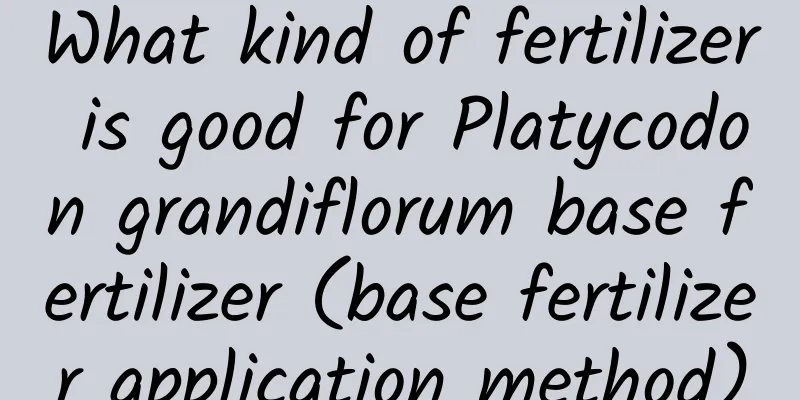What kind of fertilizer is good for Platycodon grandiflorum base fertilizer (base fertilizer application method)

Effect of Platycodon grandiflorum base fertilizerPlatycodon base fertilizer can be divided into indirect fertilizer and direct fertilizer. Direct fertilizer can directly provide various nutrients needed by Platycodon, while indirect fertilizer mainly affects the growth and development of Platycodon by improving the properties of the soil. Platycodon grandiflorum base fertilizer selectionPlatycodon uses biological organic fertilizer as base fertilizer. If there is none, use triple compound fertilizer. It is best to add potassium fertilizer in the later stage of growth, which can promote growth and increase yield. How to apply Platycodon grandiflorum base fertilizerWhen applying base fertilizer to Platycodon, you can dig a small hole around the plant and bury the fertilizer in it. The fertilizer should not be too close to the roots, but should be kept at a certain distance and not exposed to direct sunlight. How much base fertilizer should be added to Platycodon grandiflorumThe amount of base fertilizer applied to Platycodon grandiflorum is relatively large, generally accounting for more than 50% of the annual fertilizer application. If farmers' decomposed organic fertilizer is applied, 100-200 kg will be applied to each adult Platycodon grandiflorum, and 3-4 kg of lime will be added at the same time. Water-soluble fertilizer can be applied at a dosage of 5-10 kg per acre. How to apply fertilizer to Platycodon grandiflorumWhen renovating the soil for Platycodon grandiflorum, sufficient base fertilizer needs to be applied, and multiple topdressings need to be applied during the subsequent growth period to meet the growth needs of the plant, promote growth, and increase yield. 1. When the height of Platycodon grandiflorum seedlings reaches 15 cm, the first fertilizer can be applied. Human and animal manure, superphosphate, or ammonium sulfate can be applied to promote the healthy growth of the seedlings. 2. At the end of June and the beginning of July, before Platycodon grandiflorum blooms, combined with the second inter-row cultivation and fertilization, you can apply pre-flowering fertilizer, mainly human and animal manure, superphosphate or urea, superphosphate, and add soil after application to prevent rain erosion and plant lodging. You can also spray diluted dwarfing agent once in May after the first topdressing to control stem growth, thicken the plant and reduce lodging. 3. In August, you can combine inter-row cultivation and weeding with topdressing of fertilizers, such as human and animal manure and superphosphate. After winter, you can apply mixed fertilizers such as rotted manure, wood ash, compost, cake fertilizer, and superphosphate to the soil, mix them evenly, dig trenches beside the plants and apply them, cover with soil and fertilizer after application, and cultivate the soil. |
>>: How to make the first love succulent bloom
Recommend
Time and method of cutting of Dieffenbachia
Dieffenbachia cutting time Cuttings of evergreen ...
How to prune Bauhinia
Heavy Cut Bauhinia has strong adaptability. Under...
There are several types of crabapple
1. Western Begonia The crabapple tree is named af...
Which is easier to keep, the bird of paradise or the areca palm, and which is more suitable for the living room?
The difference between Bird of Paradise and Areca...
Other propagation methods of Prunus mume
The propagation method of elmleaf plum: division ...
When to repot the fiddle-leaf fig
1. Time Repotting does not need to be done every ...
Apple Growing Conditions and Characteristics
Apple Growing Conditions Apples are generally mor...
Do cacti like the sun?
Cactus likes the sun Cactus likes sunlight and is...
What is the best month to plant perilla leaves?
When to plant perilla leaves Perilla leaves are g...
How to divide African violet leaf cuttings
Time for dividing African violet leaf cuttings No...
What fertilizer is best for honeysuckle (what fertilizer can make honeysuckle grow fastest and produce the highest yield)
What fertilizer does honeysuckle like? Since hone...
How to grow plumeria on the balcony, what should you pay attention to
1. Adequate sunlight It is a strong sun-loving fl...
Do Wanchongshan prefer shade or sunshine?
Do Wanchongshan prefer shade or sunshine? Wanchon...
Jasmine planting methods and techniques
Jasmine is loved for its evergreen leaves and ele...
Can taro be grown hydroponically? Is it better to grow it hydroponically or directly in the soil?
Can taro be grown hydroponically? Taro can be gro...









